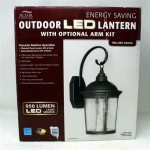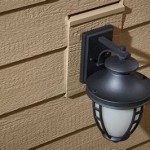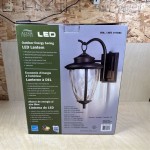Solar Panels and Batteries for Outdoor Lights: A Comprehensive Guide
The application of solar energy for powering outdoor lighting systems has become increasingly prevalent due to its environmental benefits and cost-effectiveness. The integration of solar panels and batteries offers a sustainable and autonomous solution for illuminating gardens, pathways, security areas, and other outdoor spaces. This article provides a detailed overview of solar panel and battery technologies used in outdoor lighting, addressing key components, functionalities, and practical considerations for optimal system design and performance.
Solar-powered outdoor lights operate on a simple principle: photovoltaic (PV) cells within the solar panel convert sunlight into direct current (DC) electricity. This electricity is then used to charge a battery, which stores the energy for later use, typically during nighttime hours. An electronic controller manages the charging and discharging process, ensuring the battery is not overcharged or completely drained, thereby prolonging its lifespan and maintaining consistent light operation.
The adoption of solar-powered outdoor lighting systems offers several advantages. Primarily, they reduce reliance on traditional grid electricity, leading to lower monthly utility bills. Moreover, these systems minimize carbon emissions, contributing to a cleaner environment. The ease of installation, requiring no complex wiring or trenching, makes them suitable for various outdoor locations, especially in areas where access to electricity is limited or unavailable. Finally, the automatic operation of these lights, typically controlled by sensors that detect ambient light levels, adds convenience and enhances energy efficiency.
Understanding Solar Panel Technology
Solar panels are the core components of solar-powered outdoor lighting systems, responsible for capturing sunlight and converting it into electrical energy. Several types of solar panel technologies are employed in these applications, each with its own characteristics in terms of efficiency, cost, and durability. The most common types include monocrystalline, polycrystalline, and thin-film solar panels.
Monocrystalline solar panels are manufactured from a single crystal of silicon, resulting in a highly uniform structure. This uniformity contributes to their high efficiency, typically ranging from 17% to 22%. Monocrystalline panels are known for their longevity and performance in low-light conditions, making them a reliable choice for outdoor lighting applications. However, they tend to be more expensive than other types of solar panels.
Polycrystalline solar panels, also known as multi-crystalline panels, are made from multiple silicon crystals that are melted together. Their efficiency is slightly lower than that of monocrystalline panels, usually ranging from 15% to 17%. Polycrystalline panels are generally more affordable and offer a good balance between cost and performance. They are also durable and suitable for a wide range of outdoor environments.
Thin-film solar panels are created by depositing one or more thin layers of photovoltaic material onto a substrate, such as glass, plastic, or metal. These panels are less efficient than crystalline silicon panels, with efficiencies typically ranging from 10% to 13%. However, they offer greater flexibility in terms of size and shape, and they can be manufactured at a lower cost. Thin-film panels are also less affected by shading, making them suitable for locations with partial or intermittent sunlight.
The size and power rating of the solar panel must be carefully selected based on the energy requirements of the outdoor light and the average daily sunlight hours in the location. A higher power rating will ensure sufficient energy generation to charge the battery, even during periods of cloudy weather. The positioning of the solar panel is also crucial; it should be placed in a location where it receives maximum sunlight exposure throughout the day, ideally facing south in the northern hemisphere and north in the southern hemisphere.
Exploring Battery Technology for Outdoor Lights
Batteries are essential components in solar-powered outdoor lighting systems, providing energy storage that allows the lights to operate during nighttime hours or when sunlight is unavailable. Different types of batteries are used in these applications, each with its own advantages and disadvantages in terms of capacity, lifespan, and maintenance requirements. The most common types include nickel-cadmium (NiCd), nickel-metal hydride (NiMH), and lithium-ion (Li-ion) batteries.
Nickel-cadmium (NiCd) batteries were one of the earlier types of rechargeable batteries used in solar lights. They are known for their durability and ability to withstand deep discharge cycles. However, NiCd batteries have a lower energy density compared to other battery types, meaning they store less energy for their size and weight. They also contain cadmium, which is a toxic heavy metal, raising environmental concerns regarding their disposal.
Nickel-metal hydride (NiMH) batteries offer a higher energy density compared to NiCd batteries, allowing for longer run times for the outdoor lights. They are also more environmentally friendly, as they do not contain cadmium. NiMH batteries are susceptible to self-discharge, meaning they lose charge even when not in use. They also have a limited lifespan compared to other battery types, typically lasting for a few hundred charge-discharge cycles.
Lithium-ion (Li-ion) batteries are the most advanced type of rechargeable battery used in solar-powered outdoor lighting systems. They offer a high energy density, long lifespan, and low self-discharge rate. Li-ion batteries are also lightweight and compact, making them suitable for portable applications. However, they are more expensive than other battery types and require sophisticated charging circuitry to prevent overcharging or overheating. LiFePO4 (Lithium Iron Phosphate) batteries are a subtype of Li-ion batteries known for their enhanced safety and longer lifespan, making them increasingly popular for outdoor lighting applications.
The capacity of the battery, measured in Ampere-hours (Ah), determines how long the outdoor light can operate on a single charge. A higher capacity battery will provide longer run times, but it will also take longer to charge. The battery voltage must also match the voltage requirements of the LED light and the solar panel. Proper maintenance of the battery, including regular cleaning and avoiding extreme temperatures, is essential to prolong its lifespan and ensure consistent performance.
Designing and Maintaining Solar-Powered Outdoor Lighting Systems
Designing effective solar-powered outdoor lighting systems requires careful consideration of several factors, including the location, energy requirements, and environmental conditions. The goal is to select the right components and configure them in a way that maximizes energy generation, storage, and light output. Proper installation and maintenance are also crucial for ensuring the long-term reliability and performance of the system.
The first step in designing a solar-powered outdoor lighting system is to assess the location. Factors such as the average daily sunlight hours, shading from trees or buildings, and prevailing weather conditions must be taken into account. The solar panel should be positioned in a location where it receives maximum sunlight exposure throughout the day. The battery and controller should be housed in a weatherproof enclosure to protect them from rain, snow, and extreme temperatures.
Next, the energy requirements of the outdoor light must be determined. This includes the wattage of the LED light, the desired operating hours per night, and any other power-consuming components. The solar panel and battery should be sized accordingly to provide sufficient energy to meet these requirements. It is important to factor in a safety margin to account for cloudy weather and battery degradation over time.
Regular maintenance is essential for ensuring the long-term performance of solar-powered outdoor lighting systems. This includes cleaning the solar panel to remove dirt and debris, inspecting the battery for signs of corrosion or damage, and checking the wiring and connections for loose or frayed wires. The battery should be replaced periodically, typically every 3-5 years, to maintain optimal energy storage capacity. It is also important to monitor the system's performance and make adjustments as needed to optimize energy generation and light output. For example, adjusting the angle of the solar panel to maximize sunlight exposure or replacing a dimming LED light can help improve the system's efficiency.
The integration of smart technologies, such as remote monitoring and control systems, can further enhance the performance and efficiency of solar-powered outdoor lighting. These systems allow users to track energy generation, battery status, and light output remotely, and to make adjustments as needed to optimize performance. They can also provide alerts in case of system malfunctions, allowing for prompt repairs and minimizing downtime. As technology continues to advance, solar-powered outdoor lighting systems are becoming increasingly sophisticated and reliable, offering a sustainable and cost-effective solution for illuminating outdoor spaces.

Outdoor Lighting Foundry Giant Zhl Group Announced Space Series Modular Solar Street Lights

How To Make Solar Power Outdoor Lights Just Measuring Up

Convert Outdoor Light To Solar 3 Easy Ways With Diagrams Spheral

Oculi Solar Panel Kit Wall Bracket Batteries And Adaptor Quality Essential Distribution Qed

1 5v 0 65w Mini Solar Panel Small Cell Module Battery Charger For Garden Lights

How To Make Solar Power Outdoor Lights Just Measuring Up

1000 Lumens Powerful Outdoor Solar Light Led Flood With 5000mah Large Capacity Battery Continuous Lighting Without Motion Sensor For Passageway Garage Garden

Solar Outdoor Lights Panel Light Long Lasting Battery Lamp Waterproof High Brightness Remote Control Garden Energy Saving Shein Usa

Solar Panel 3700milliamperes Power Supply For Outdoor String Lights Waterproof Rechargeable Battery Com

Do Solar Garden Lights Need Batteries Outdoorlights The
Related Posts







